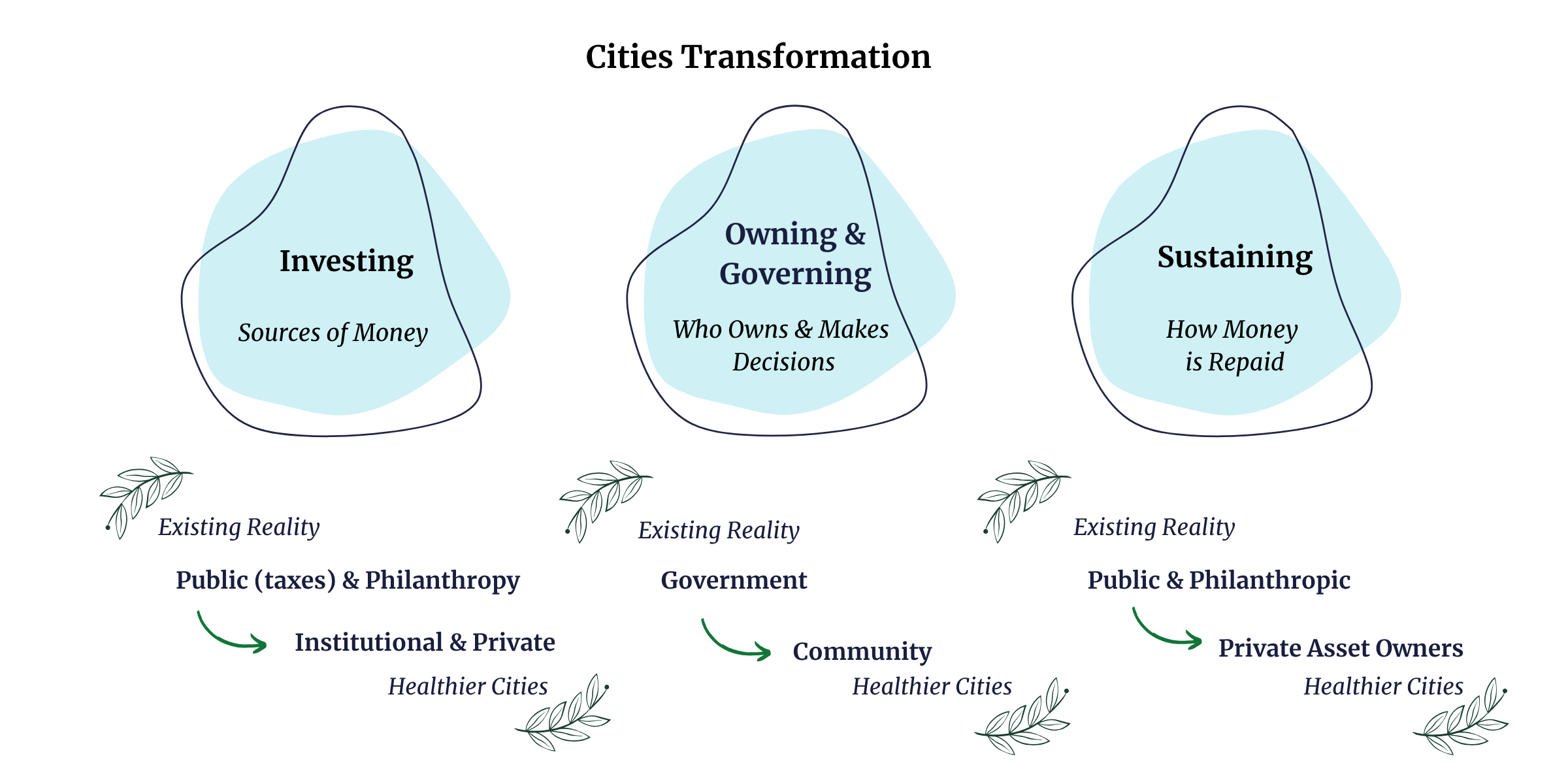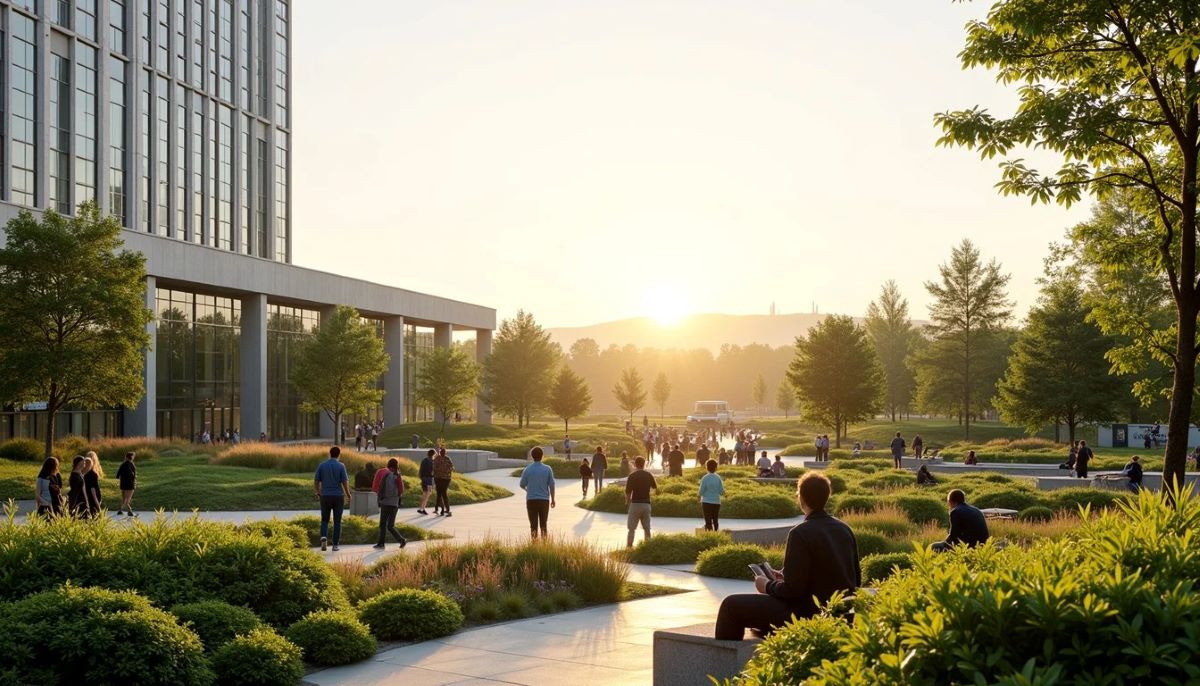Healthier Cities
Cities: A place many of us call home. Canadian cities provide opportunities, create dreams and a sense of belonging for many generations. Cities are where we work, play, live. We describe cities as strong, attractive, resilient, thriving.
In Healthier Cities, individuals and families experience joy and thrive in neighbourhoods where they feel connection to community while equally being given an opportunity to build inter-generational private value, being supported and caring for public infrastructure.
What enables Healthier Cities is their infrastructure. Cities that withstood Covid-19 had abundant access to green spaces through parks, conservation areas, ravines (natural infrastructure); wide pedestrian walkways, bicycle paths and reliable public transport (mobility infrastructure); attainable homes for everyone (real estate infrastructure); and finally functional local schools, libraries, daycares, community and medical centers, outdoor art venues (civic infrastructure). Collectively, these infrastructures enable individuals and families to experience cities to their full potential. This global experience positively impacts the overall health of individuals, decreases the drain on government resources, adds value to adjacent properties and returns the investment back into itself to better provide for our future generations.

Why do we find ourselves living with increased levels of daily homelessness, depletion of nature and biodiversity, and drastic housing unaffordability?
Why are so few Canadian cities and towns today described as Healthier?
To answer these questions, we need to understand our cities and their collective infrastructures: what are they, who pays for them, who owns and governs them, and who benefits from financial returns.
Public InfrastructureRun by government and paid for by three levels of government budgets.
Grey Infrastructure
Including roads, bridges, sewers, transport.
Civic Infrastructure
Including libraries, community centers, arts & science centers.
Public Infrastructure
Run by private institutions as well as the not-for-profit sector,
paid for by three levels of government budgets, as well as philanthropic infusions and initiatives.
Education Infrastructure
Including daycares, schools, colleges, universities.
Natural Infrastructure
lncluding parks, ravines, wetlands.
Health Infrastructure
Including hospitals, health clinics.
Vulnerable Population Infrastructure
Including homeless shelters.
Private Infrastructure
Run and owned by individuals, companies, and institutions.
Paid for by private and institutional capital.
Personal Real Estate
Including condos, townhouses and detached single-family homes.
Commercial Real Estate
Including rental, office, retail and industrial properties.
Ombrello Solutions
Healthier Cities are where individuals and families thrive by being given an opportunity to build intergenerational private value while caring for and being supported by public infrastructure. Ombrello Solutions is focused on bringing our Cities back to being Healthier Cities. We build systemic investment instruments that transform the existing way of investing, owning, governing and sustaining civic & natural infrastructure.

Outcomes for Healthier Cities
The immediate direct contributions towards Healthier Cities by Ombrello Solutions systemic investment instruments:
- Acquiring ~ 200 acres of sites currently zoned for redevelopments across Quebec and Ontario cities, safeguarding its biodiversity, supporting natural ecosystem services, integrating climate adaptation and importantly providing civic access.
- Acquiring and providing 400 permanent homes for individuals and families currently living on the streets of Canada due to evictions brought by the unaffordability crisis.
- Transferring all acquired assets into community ownership through the Community Endowment Trust/ Fiducie D’Utilité Sociale, ensuring long-term financial viability and collective decision making.
- Generating new private value, a portion of which is redistributed for perpetual maintenance and protection of the acquired civic and natural assets.
Focus of Our Work
To enable systemic investment instruments, Ombrello Solutions proposes three key innovations. They assure the preservation and growth of Healthier Neighborhoods across Canada.

Infrastructure Investment
Allocation of private and institutional capital towards civic infrastructure: those public assets that make the neighbourhood be most desirable.

Community Ownership
Ownership of these assets by the community through Community Endowment Funds.

Smart Civic Covenant
Repayment of the investment with a small regular redistribution of the created value of commercial real estate properties that are geographically adjacent to the civic infrastructure.
Healthier Cities
How do we recreate the Healthier neighbourhoods to become the core fabric of all our cities? How do we maintain a healthy balance between public and private infrastructure, and avoid the risk of making these places unaffordable and closed off to certain parts of the population? How do we care for the vulnerable population who lives there? How do we preserve the Health of the areas we all love?
In Healthier Cities, we build resilient financial models for parks, schools, daycares, places for arts & culture.
In Healthier Cities, we empower every individual in the community through Community Endowment Funds.
In Healthier Cities, we ensure that the most vulnerable members are cared for.
In Healthier Cities, we create private value, a redistributed a portion of it for regeneration and maintenance of civic infrastructure.
When we succeed every Canadian city will be Healthier. We will all live and thrive in neighbourhoods where our lives are supported and enriched by the assets that surround us.
Portfolio of Assets
Attainable Housing for All
Libraries
Medical Centers
Large Parks & Biodiversity
Excellent Public Schools
Community Centres
Quality Public Daycares
Homeless Individuals Living with Dignity